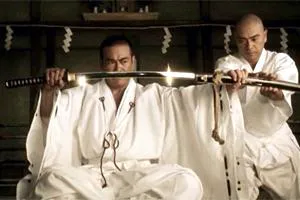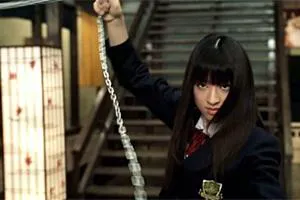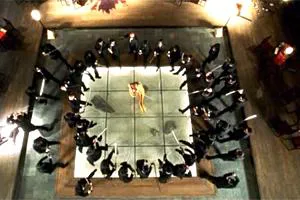Kill Bill: A Quentin Tarantino Film
“Kill Bill” – “Quentin Tarantino’s fourth film,” as he proudly proclaims in the credits. The once-hopeful of world cinema and eccentric guru of cinephiles has awakened from a six-year coma, delivering pure, unadulterated emptiness to the rapturous cries of his fans. “Kill Bill” reads like a motto, a life program. After watching “Volume 1” of the film, we’ll see that this is indeed the case…

“Kill Bill” reads like a motto, a life program. After watching “Volume 1” of the film, we see that this is indeed the case: the nameless Bride, nicknamed “Black Mamba,” awakens from a four-year coma and embarks on a path of revenge against those who put her in it. She needs to eliminate the “Deadly Vipers” and a certain Bill, whom we don’t even see in the first part.
“Kill Bill” as a slogan is no better than a poster plastered across Moscow that reads “Being alive is cool”: polar opposites in meaning, both born of aggressive brainlessness.

We don’t know why Bill and the Vipers abused the pregnant Bride. We’re not interested in who these people are. It doesn’t matter where the terminator in a skirt got so much strength and combat talent after the coma. There’s no one to sympathize with, nothing to empathize with, any work for the mind is against the law here: we should only be interested in the process itself. Like in a video game “quest”: you need to kill five monsters without sentimentality or reflection, and then the main monster, sitting in the finale. The motives of actions, characters, fates of heroes, even their faces are taken out of the equation – they don’t exist. There are signs: Uma Thurman in a yellow jumpsuit and enemies. The enemies are mainly in kimonos, because the action moves from Pasadena to Okinawa and reproduces the technologies of Japanese-Hong Kong kung fu action films. The Japanese will probably laugh a lot seeing how the bulky Uma Thurman, in an awkward rope fouetté, lays down hordes of screaming, slanted-eyed people.
This quest barely stretched to an hour and a half, but after six years of silence, the author ran out of money and wanted to earn some. He left in the montage everything that should have flown into the trash, and, although the film often practically stops, stretched it to more than three hours. And then he divided it into two “volumes,” with the second coming out in February, allowing the first to collect all possible harvest.

He didn’t risk introducing another five characters to alternately slaughter in another two “volumes.” A pity – such a picture can be pulled endlessly, like sausages from a sausage machine.
The Structure and Violence
“Volume 1” is divided into chapters. Each with a murder, single or collective. All the murders are excessive, as in a “quest,” the killed spew fountains of blood, like bottles of champagne. Tarantino doesn’t hide that he’s having fun and invites viewers to have fun. Many buy into it, laugh merrily at the effectively severed scalp and applaud when spaces filled with black Japanese people boil and bubble with carbonated blood.

Influences and Imitations
From each new Tarantino film, you can understand what he watched the day before. In this case, he watched not only Ang Lee’s “Crouching Tiger, Hidden Dragon,” but also Hayao Miyazaki’s Japanese animation “Princess Mononoke.” This prompted him to make his own version of “Tiger,” only more ponderous, and to order Japanese animators to make their own version of “Mononoke,” only more clumsy. The result is a collage stitched together from different-sized pieces of color, black-and-white, and animated film. No artistic justifications are given for the alternation. Perhaps the author himself noticed the monotony of the work and decided to color it in the easiest way.
One of the film’s participants promised: “The picture turned out so cruel that viewers will either leave from the middle, or they will vomit right in the chair.” The actress greatly exaggerated: the film is not scary, as a quest is not scary, and if it is nauseating, it is because it is boring. It suppresses with quantity, dulls feelings, and quickly accustoms the audience not to be afraid of either megaliters of blood or hundreds of severed limbs. It is designed for the release of adolescent adrenaline, which for Tarantino is as necessary a physiological process as urination. We are entertained by humor like “Buck-Fuck.” An attempt to rape a comatose woman, in response to which she tears out the rapist’s tongue with her teeth. Creatively impotent epigonism, clumsy copying of Japanese samples, including a twenty-year-old remix of the Russian “Flight of the Bumblebee” in the soundtrack. Borrowed from Jarmusch energy, and so, as if a child redrew Rembrandt – cell by cell, not understanding the meaning.

Tarantino: The Video Generation
Tarantino is the first major child of the “videot” generation. The former video rental clerk didn’t read books, but watched a lot of films. The repertoire of video rental shops is well known – all art for Tarantino was reduced to cool “action.” The future idol of generations learned from bad cinema in bad television images. And if a good one accidentally came across, he took from it what was “cool,” without asking himself impossible questions about meaning and moral evaluations. He learned to imitate these tops very cleverly – directly or as if parodying. Like any guru of the postmodern era, he is a man who has picked up a lot, but is uneducated. And impotent in terms of his own creativity.
In “Pulp Fiction,” he amazed the world by completely separating physical action from thought processes. He transferred the principle “strength is – no mind is needed” to the very process of filmmaking. He stepped as if into a new space, unusually comfortable for those to whom any thought seems burdensome. Therefore, half of the premiere hall in Cannes in 1994 was delighted, the other shouted: “American shit!”. With Tarantino’s cinema, we returned to the era when humanity lived in a cave and did not yet know human laws. It only knew how to fuck and cut each other. This new cave has digital technologies, but Shakespeare, humanism, philosophy, the commandments protecting humanity, and the very need to think – all this is no longer planned. Therefore, Tarantino is an innovator: he promotes a one hundred percent brainless product in cinema. He is a robot, copying samples at the digital, perfect, but lifeless level at which a computer beats Kasparov. And now, with his films, he is cloning millions of his kind.

The Mystery of Success
The mystery is in another thing: why is an initially rotten product so in demand in the market? Why is there such hysteria around the epigone? And why, while some critics wrinkle their noses disdainfully, others, competing with advertising, hammer into the heads of the gullible that this is good, that this is the best in the world, that this cannot be missed, that brainless is modern?
So, is brainlessness the ideal to which, returning to a vegetative state, humanity instinctively strives?